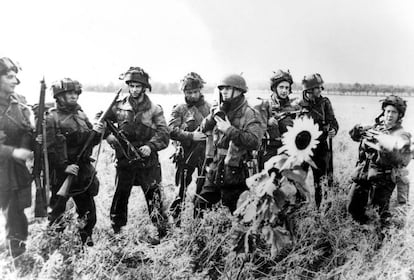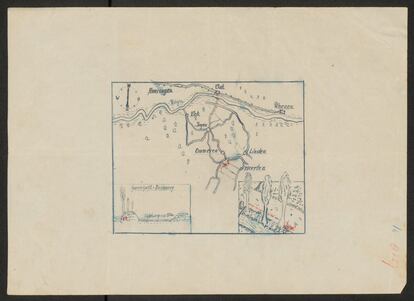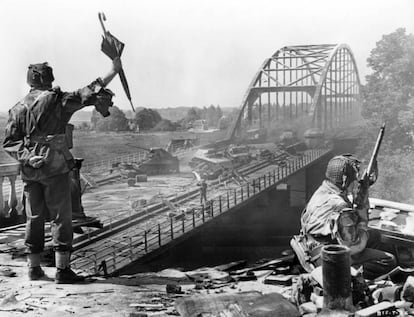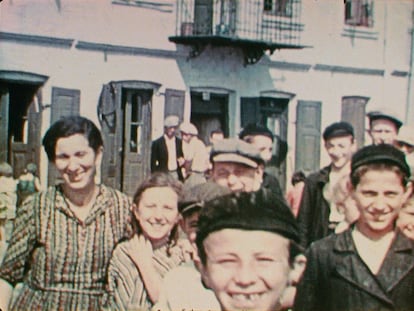Netherlands declassifies Nazi World War II map of buried treasure near Arnhem
The National Archives of the Netherlands has released documents concerning jewelry and gems that were supposedly hidden after the looting of a bank in 1944


Every year, the National Archives of the Netherlands (NA) publishes thousands of documents that were either previously unseen by the public or available for study only under strict security measures. Among those released this January is a treasure map showing the suspected location of a trove of jewelry, watches and precious stones that were supposedly stolen by a group of German soldiers in 1944. Classified until now and drawn by hand, the map describes the region where the haul, which has never been located, was supposedly stashed. According to the sketch, the valuables were buried near Ommeren, in the eastern Netherlands, in a place that has been searched three times already by the authorities.
The story, as it appears in the documents released by the NA, is as follows. In August 1944 during a bombardment, a branch of the Rotterdamsche Bank (now ABN Amro) was damaged in Arnhem, around 25 miles from Ommeren. The contents of the safes stored there were scattered in the street and “the German soldiers filled their pockets with the loot,” says Annet Waalkens, an advisor the NA, via telephone. Operation Market Garden, an allied attempt to force a bridgehead over the Rhine to strike at northern Germany, was launched in September 1944. According to the documents, “they put the jewels inside ammunition crates and hid them in the carriage of a train.” “We had thought they buried it in 1945, a couple of weeks before the liberation of the area by the Allies, somewhere in Ommeren,” says Waalkens.

The files names a Sergeant Major Kastel, a Sergeant Bräuer and a Private Biebert as the soldiers who took the haul. They were seen by another German soldier called Helmut, who was born in 1925. Helmut mentions August 1944 as the time when the bank was hit by a shell “and then he had to keep watch when the boxes were buried,” says Waalkens. According to experts, the men were members of Major Rudolf Witzig’s parachute battalion, one of the elite formations of the German Wehrmacht. The Dutch military mission stationed in Berlin followed the trail of rumors about the existence of such treasure, consulting with the heads of the Dutch institute that reviewed the fate of the haul: the data matched. “They then sought out the soldier, who was living in the German town of Baden-Baden, and took a statement. As the map was among his possessions, he was taken to the Netherlands to help search for the treasure. Two of the three servicemen who buried the jewels died later during the war. The third could not be located,” Waalkens recounts.
Despite the terrain on the map being thoroughly searched on three occasions, the ammunition crates containing the jewels were never found. The authorities laid out a few possible scenarios before abandoning the search. “It could be that the soldier, Helmut, invented the whole thing; perhaps a Dutch farmer in the vicinity dug it up; or someone from the Dutch institute that investigated the matter took advantage of their position,” says Waalkens. The authorities also thought that a US officer stationed in the area at the time may have discovered it.
For Historian Joost Rosendaal, of the Radboud University in Nijmegen, the story is intriguing and should be investigated, although he questions the sequence of events. “We knew there were bombardments in the lead-up to Operation Market Garden, but no banks in Arnhem were hit,” he tells EL PAÍS over the phone. “Several banks in the city were looted in late 1944 and February 1945.” He also notes that the Witzig battalion was fighting on the eastern front in Latvia and Lithuania in August 1944. “They only arrived in the Dutch region we are talking about in February 1945.” Rosendaal also states that all the fighting, bombing and looting of banks in the area is documented, “and the Germans forced the population of Arnhem from their homes because of the fear of resistance fighters, and because they wanted an open battlefield,” in the face of the Allied advance. Arnhem was empty at the end of September 1944, “and looting was widespread.” Local residents were forced to leave on foot. “They left with nothing and when they returned there was nothing left,” he says. The Allies liberated Arnhem on April 15, 1945.

Arnhem was a key objective of Market Garden, which took place between September 17 and 27 of 1944 and was designed to secure bridges across the Rhine for an infantry push into Germany. The river formed a natural border and the German Army had several armored divisions in the region, which for six months became the front line between Wehrmacht and Allied troops. Market Garden ultimately fell short of Arnhem, despite liberating Eindhoven and Nijmegen, and is considered one of the biggest military failures of World War II. Rosendaal explains that the part of Ommeren indicated on the map as the site where the treasure is buried “was an aristocratic property used by the Nazis as a headquarters, and bombed by the Allies on April 24, 1945.”
Sign up for our weekly newsletter to get more English-language news coverage from EL PAÍS USA Edition
Tu suscripción se está usando en otro dispositivo
¿Quieres añadir otro usuario a tu suscripción?
Si continúas leyendo en este dispositivo, no se podrá leer en el otro.
FlechaTu suscripción se está usando en otro dispositivo y solo puedes acceder a EL PAÍS desde un dispositivo a la vez.
Si quieres compartir tu cuenta, cambia tu suscripción a la modalidad Premium, así podrás añadir otro usuario. Cada uno accederá con su propia cuenta de email, lo que os permitirá personalizar vuestra experiencia en EL PAÍS.
¿Tienes una suscripción de empresa? Accede aquí para contratar más cuentas.
En el caso de no saber quién está usando tu cuenta, te recomendamos cambiar tu contraseña aquí.
Si decides continuar compartiendo tu cuenta, este mensaje se mostrará en tu dispositivo y en el de la otra persona que está usando tu cuenta de forma indefinida, afectando a tu experiencia de lectura. Puedes consultar aquí los términos y condiciones de la suscripción digital.
More information
Archived In
Últimas noticias
Most viewed
- Sinaloa Cartel war is taking its toll on Los Chapitos
- Oona Chaplin: ‘I told James Cameron that I was living in a treehouse and starting a permaculture project with a friend’
- Reinhard Genzel, Nobel laureate in physics: ‘One-minute videos will never give you the truth’
- Why the price of coffee has skyrocketed: from Brazilian plantations to specialty coffee houses
- Silver prices are going crazy: This is what’s fueling the rally









































